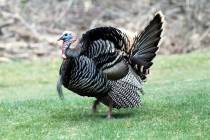Key to effective bait sometimes is its simplicity
In addition to being outdoors, one of the great things about fishing is that every outing is another opportunity to experience something new. And each new experience is a chance to learn something. This is especially true when you can learn from someone who knows more than you.
This week I learned the secret of the Cheeto Fly. My teacher was John Campbell, a professional fishing guide, college fly-fishing instructor and creator of the Cheeto Fly. I heard the name of this fly pattern more than once over the years, but never had seen one until last weekend while participating in one of Campbell's fly-fishing classes at Lake Las Vegas.
As you might suspect, the Cheeto Fly is so named because it resembles an orange Cheeto, especially when it floats on the water. Being a fly tier of medium ability, I had given thought as to how one might tie a fly designed to resemble a floating Cheeto, but my visions of a large ball of orange yarn tied to a hook seemed to come up short.
Joining me in class was my youngest son, Hyrum. For the first three hours, we learned about equipment, to tie essential knots and to identify the major categories of bugs that fish like to eat. After a break for lunch, each student was provided with a six-weight Orvis fly rod and given a quick lesson in fly casting. During this portion of the class, Campbell and one of his assistants helped Hyrum correct a problem with his fly-casting technique, something I had been unable to do. Perhaps it was one of those father-son communication things.
After making sure we could cast a fly without hooking a passerby, Campbell turned his eight students loose along the shoreline below the Montelago Village Resort. I tied on one of Campbell's Cheeto Flies and went to work, though I couldn't help but laugh upon seeing it. The fly is made by cutting in half one of those orange, foam ear plugs and sliding one of the pieces onto a number 4, short-shank, Octopus hook.
On the water, the Cheeto Fly did what it was supposed to do. It looked like a Cheeto floating on the water, and it didn't take long for a Great Basin bonefish -- aka carp -- to eat the fly, and I set the hook. Then it was off to the races as the fish peeled line from my reel. Unfortunately, the fish broke me off just as I brought him close to shore.
A short time later, Hyrum hooked into a large carp. This one stayed on the hook, and the contest between Hyrum and the fish soon became a battle of wills. Don't listen when someone tells you carp don't fight. They put up a great fight, and battling them on a fly rod is some kind of fun. It also would seem that the key to an effective bait sometimes is found in simplicity.
More information about Campbell's offerings can be found at Outdoorsource.net.
Freelance writer Doug Nielsen is a conservation educator for the Nevada Department of Wildlife. His "In the Outdoors" column, published Thursday in the Las Vegas Review-Journal, is not affiliated with or endorsed by the NDOW. Any opinions he states in his column are his own. He can be reached at intheoutdoorslv@gmail.com.

















